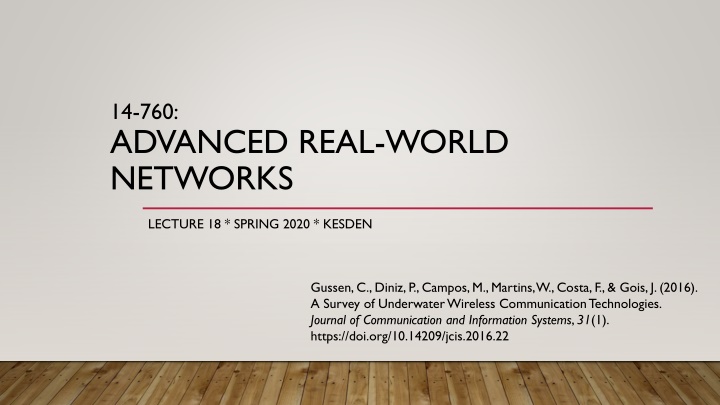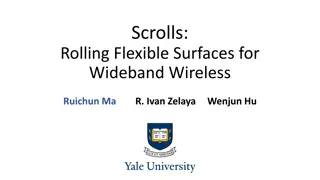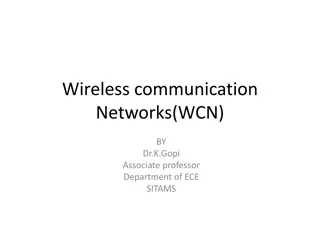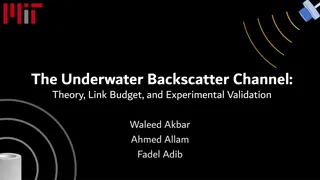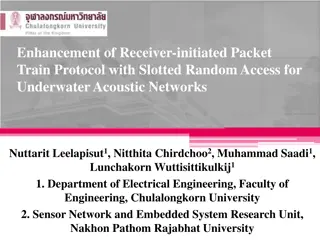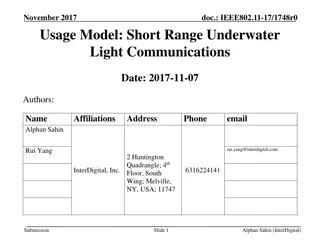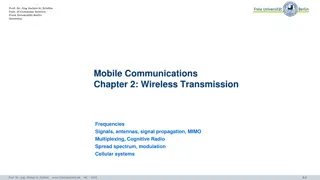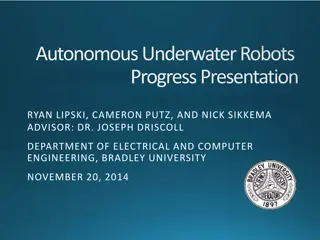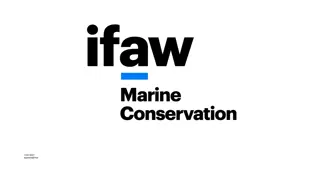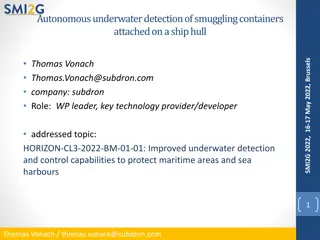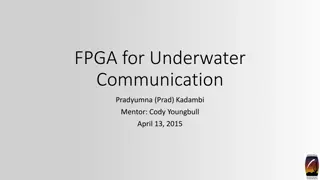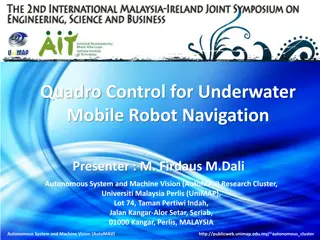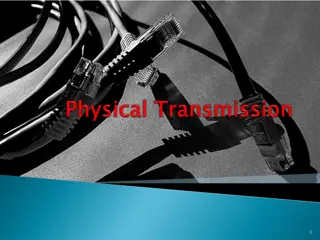Underwater Wireless Communication Technologies Overview
This content provides insights into underwater wireless communication technologies including Radio Frequency (RF) and Acoustic technologies. It covers the challenges, characteristics, and propagation of RF signals in water, along with the Doppler effect and multipath considerations. The applications of underwater wireless communication in environmental monitoring, oil and gas exploration, national defense, and examples of controlling Autonomous Underwater Vehicles (AUVs) are also discussed.
Download Presentation

Please find below an Image/Link to download the presentation.
The content on the website is provided AS IS for your information and personal use only. It may not be sold, licensed, or shared on other websites without obtaining consent from the author.If you encounter any issues during the download, it is possible that the publisher has removed the file from their server.
You are allowed to download the files provided on this website for personal or commercial use, subject to the condition that they are used lawfully. All files are the property of their respective owners.
The content on the website is provided AS IS for your information and personal use only. It may not be sold, licensed, or shared on other websites without obtaining consent from the author.
E N D
Presentation Transcript
14-760: ADVANCED REAL-WORLD NETWORKS LECTURE 18 * SPRING 2020 * KESDEN Gussen, C., Diniz, P., Campos, M., Martins, W., Costa, F., & Gois, J. (2016). A Survey of Underwater Wireless Communication Technologies. Journal of Communication and Information Systems,31(1). https://doi.org/10.14209/jcis.2016.22
UNDERWATER WIRELESS Environmental monitoring Oil and gas exploration and industry National defense, e.g. coastal defense Examples Controlling AUVs Seafloor sensors Etc
TECHNOLOGIES Radio Frequency (RF) High data frequency, but short range Doppler effect is somewhat limiting Optical transmission Blue-green wavelength We see water as blue-green because less absorbed Line of sight Acoustic Most common Longest range Lowest throughput, because Doppler Effect is severely limiting Possible interference with marine life, e.g. marine mammals that use sonar
DOPPLER EFFECT: REFRESHER Apparent bunching up of waves as transmitter approaches receiver As distance shrinks it takes less time for wave to propagate As sender gets closer, waves take less time to propagate Same if receiver gets farther away Movement of medium, e.g. water, also matters This leads receiver to observe shrinking, not constant, frequency Worse at lower frequencies https://commons.wikimedia.org/wiki/File:Doppler_effect_diagrammatic.svg
RADIO FREQUENCY (RF) CHARACTERISTICS IN WATER Paper provides paper showing relationship of factors below to propagation Carrier frequency, conductivity, temperature Salinity, which significantly effects conductivity, is a big one. Seawater is highly conductive Severe impact on propagation of radio waves Most prominent at VHF and UHF frequencies Limits links to ~10m VLF (3 Hz 3 kHz) to and ELF (3 kHz to 30 kHz) Can reach kilometers Very low bandwidth = very low data rate High power, large and expensive equipment Not good for sensor networks underwater! (For example)
RADIO FREQUENCY (RF) PROPAGATION
RADIO FREQUENCY MULTIPATH Multipath problem Can include paths through sea floor and air Remember this one? Not necessarily a problem anymore Multiple paths Don t fight them w.r.t. data rate Let them reinforce signal by expanding it.
RF NOISE IN UNDERWATER Not commonly discussed in open literature Militaries probably have studied this the most Like Gaussian
RADIO FREQUENCY (RF): MAKING IT WORK Obviously need transceivers that are sealed underwater At least cooling is usually easy Use multiple carriers to get enough bandwidth Significant energy requirements, esp. with distance Solar power isn t likely Water movement may help Batteries, but had to change and limited life
OPTICAL COMMUNICATION CHARACTERISTICS IN WATER Sea water is a conductor for RF, but dielectric for optical communication Conductors move charge Dielectrics are polarized by charge, but are insulators Changes over at about 250 GHz Dielectrics have lower RF attenuation than conductors
OPTICAL COMMUNICATION CHARACTERISTICS IN WATER, CONT. Speed of light in water is 4-5 orders of magnitude larger than propagation of acoustic waves. Much lower latency Much more negligible Doppler effect Blue-green spectrum works best Water looks blue-green because rest is absorbed Tends to be line of site Target tracking is painful.
OPTICAL COMMUNICATION: OPTICAL PROPERTIES Inherent Optical Properties (IOP) Depend only upon properties of medium, i.e. water Two key properties: Spectral absorption coefficient Spectral volume scattering function Apparent Optical Properties Depend upon properties of light source
OPTICAL COMMUNICATION: INHERENT OPTICAL PROPERTIES Two key properties: Spectral absorption coefficient Process by which light (and other emag radiation) becomes heat Chlorophyll, salts, water molecules, etc. Spectral volume scattering function Salt ions, particulate matter, etc. Apparent Optical Properties Depend upon properties of light source Tends to be less important than OOP More constant and predictable
OPTICAL COMMUNICATIONS: NOISE Main types: Excess noise Generated by amplification at receiver. To be expected in any amplifier. Quantum hot shot noise Optical receivers depend upon photon counting, which is a bit of a random process Optical excess noise Transmitters aren t perfect. To be expected in any transmitter Optical background noise Other light in environment, e.g. from sun, reflections, florescence, etc. Photodetector dark current noise Leakage, e.g. inefficiency, in light detector Electrical noise As with any electrical circuit
OPTICAL COMMUNICATIONS: TRANSDUCER TRANSMITTERS Generate and receive optical signals Typically LED or Laser source LED has advantage of being inexpensive and relatively low power But shorter range Lasers are very varied, but generally more expensive, power consuming and longer distance Tunable lasers can be adaptive to environmental characteristics Likely less efficient than LEDs, by a lot.
OPTICAL COMMUNICATIONS: TRANSDUCER RECEIVERS Lens to focus light Photosensor to convert it to electrical signal for processing The larger the aperture size on the sensor, the more it can collect More/Bigger lenses can be used to focus and concentrate light from greater area
OPTICAL COMMUNICATION: CHALLENGES Tracking to keep point-to-point Interruption by passing marine life, etc. Must be tracked so as not to result in holes in data stream Water turbidity (clarity)
ACOUSTIC COMMUNICATIONS Dominant technology Avoids attenuation of RF Avoid point-to-point nature of light, e.g. turbidity, marine life, etc Transmission in air still propagates 4-5x faster than acoustic waves in water Multipath problem Different elements in environment absorb different sound frequencies differently Attenuation in water grows with frequency Low speeds increase propagation time Which magnifies Doppler effect.
ACOUSTIC COMMUNICATIONS: POWER LOSS Spreading Over sphere or cylinder (long ranges due to bounding by floor and surface) from transmitter Absorption Sounding turning into heat, esp. prevalent for higher frequencies Also increase with distance Scattering Impact of obstancles
ACOUSTIC COMMUNICATIONS: NOISE Ambient Part of marine environment Earth movement, water movement, etc External Marine animals, surface activity, ice cracking, boating, etc.
ACOUSTIC COMMUNICATIONS: TRANSDUCERS Produce and receive sound Transmit, then listen, not simultaneous Usually same element transmits as receives Can be organized into directional arrays
ACOUSTIC COMMUNICATIONS: CHALLENGES AND SOLUTIONS Doppler effect Need fast learning and tracking algorithms, e.g. Kalman filters Still a big factor Low bandwidth Can use multiple channels simultaneously Processing at receiver can be more complex than RF or light Increased propagation time and multipath means more time for interferenfe This all needs to be managed
UNDERWATER NETWORKS (UWNS) Collect data from under water Oil & gas, military, environmental monitoring, Tsunami warning, earthquake monitoring, etc. Nodes need to be able to store significant data while it is sent Bigger buffers may be needed due to transmission ode Where to get the energy? Cost per byte is way higher than traditional networks Physical requirements Ocean is brutal, e.g. surrounded by water w/pressure, salt, movement, marine life, etc.
UNDERWATER NETWORKS (UWNS) Movement of transmitters and receivers if mobile Even a little mobile, such as buoys Relaying data may be better than transmitting farther For the same reason it was in land-based mesh networks Low frequencies go father But, well, that data rate How-to-hop fast, or long distance slow
